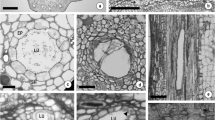Abstract
Copaifera langsdorffii Desf., popularly known as copaíba, is an oleoresin-producing tree has been overexploited in Brazil by the pharmaceutical, cosmetic and varnish industries. Despite the long history of the use of this species, the structural knowledge on the resin-producing sites remains inadequate and is limited to the trunk. The aim of this study was to describe the origin, structure and developmental features of secretory spaces present in shoot and root wood of C. langsdorffii, based on the usual techniques of wood anatomy studies. Both root and shoot wood present secretory canals distributed along the marginal parenchyma bands which delimit growth layers. Secretory canals are constituted by a locally biseriate epithelium and lume that contains terpenes. They are arisen in the cambial zone from fusiform cambial initial cells and, eventually, ray initials. The origin of lumen is schizogenous. The epithelial cells have meristematic potential and are responsible for the locally biseriate epithelium. Mature secretory canals are wider and are separated between themselves only by a row of radial cells. The fusion of these adjacent secretory canals is frequent and results from the radial cell collapse. The finding of an interconnected system of resin canals in C. langsdorffii might be of value in terms of sustainable extraction of the resin and realistically assess its sustainable harvest potential.



Similar content being viewed by others
References
Bruneton J (1987) Eléments de Phytochimie et de Pharmacognosie. Lavoisier, Paris
Bukatsch F (1972) Bemerkungen zur Doppelfärbung Astrablau-Safranin. Mikrokosmos 61:255
David R, Carde JP (1964) Coloration différentielle dês inclusions lipidique et terpeniques des pseudophylles du pine maritime au moyen du reactif Nadi. C R Acad Sci Paris D 257:1338–1340
Fahn A (1979) Secretory tissues in plants. Academic Press, London
Fueyo GM (1986) Ontogenia de las glandulas foliares e involucrales de Tahetes minuta (Compositae). Bol Soc Argent Bot 24:403–410
Harbone JB (1993) Introduction to ecological biochemistry, 4th edn. Academic Press, London
Johansen DA (1940) Plant microtechniques. McGraw-Hill, New York
Langenheim JH (2003) Plant resins: chemistry evolution, ecology and ethnobotany. Timber Press, Portland
Langenheim JH, Stubblebine WH, Lincoln DE, Foster CE (1978) Implications of variation in resin composition among organs, tissues and populations in the tropical legume Hymenaea. Biochem Syst Ecol 6:299–313. doi:10.1016/0305-1978(78)90050-9
Lersten NR, Curtis JD (1996) Survey of leaf anatomy, especially secretory structures, of tribe Caesalpinieae (Leguminosae, Caesalpinioideae). Plant Syst Evol 200:21–39. doi:10.1007/BF00984746
Liang S, Wang H, Yang M, Wu H (2009) Sequential actions of pectinases and cellulases during secretory cavity formation in Citrus fruits. Trees (Berl) 23:19–27. doi:10.1007/s00468-008-0250-7
Marcati CR, Angyalossy-Alfonso V, Benetati Lucimar L (2001) Anatomia comparada do lenho de Copaifera langsdorffii Desf. (Leguminosae–Caesalpinioideae) de floresta e cerradão. Rev Bras Bot 24:311–320. doi:10.1590/S0100-84042001000300010
Monteiro WR, Castro MM, Fahn A, Caldeira W (1995) Observations on the development of the foliar secretory cavities of Porophyllum lanceolatum (Asteraceae). Nord J Bot 15:69–76
Paiva EAS, Machado SR (2007) Structural and ultrastructural aspects of ontogenesis and differentiation of resin secretory cavities in Hymenaea stigonocarpa (Fabaceae–Caesalpinioideae) leaves. Nord J Bot 24:423–431
Paiva EAS, Oliveira DMT, Machado SR (2008) Anatomy and ontogeny of the pericarp of Pterodon emarginatus Vogel (Fabaceae, Faboideae) with emphasis on secretory ducts. An Acad Bras Cienc 80:455–465. doi:10.1590/S0001-37652008000300007
Pinto AC, Braga WF, Rezende CM, Garrido FMS, Veiga VF Jr, Bergter L, Patitucci ML, Antunes OAC (2000) Separation of acid diterpenes of Copaifera cearensis Huber ex Ducke by flash chromatography using potassium hydroxide impregnated silica gel. J Braz Chem Soc 11:355–360
Plowden C (2003) Production ecology of copaíba (Copaifera spp) oleoresin in the eastern Brazilian Amazon. Econ Bot 57:491–501. doi:10.1663/0013-0001(2003)057[0491:PEOCCS]2.0.CO;2
Rodrigues TM, Machado SR (2004) Anatomia comparada do pulvino, pecíolo e raque de Pterodon pubescens Benth. (Fabaceae–Faboideae). Acta Bot Bras 18:381–390
Teixeira SP, Gabrielli AC (2006) Taxonomic value of foliar characters in Dahlstedtia Malme—Leguminosae, Papilionoideae, Millettieae. Acta Bot Bras 20:395–403
Teixeira SP, Castro MM, Tozzi AMGA (2000) Secretory cavities and pellucid dots in leaflets of Lonchocarpus (Leguminosae, Papilionoideae, Millettieae). Plant Syst Evol 221:61–68. doi:10.1007/BF01086380
Turner G (1986) Comparative development of secretory cavities in the tribes Amorpheae and Psoraleeae (Leguminosae: Papilionoideae). Am J Bot 73:1178–1192. doi:10.2307/2443797
Veiga VF Jr, Pinto AC (2002) O gênero Copaifera L. Quim Nova 25:273–286
Winttler GH, Mauseth JD (1984) The ultrastructure of developing latex ducts in Mammillaria heyderi (Cactaceae). Am J Bot 71:100–110. doi:10.2307/2443629
Zhang C, Fujji T, Abe H, Fujiwara T, Fujita M, Takabe K (2008) Anatomical features of radial resin canals in Pinus densiflora. IAWA J 29:179–187
Acknowledgments
We are grateful to FAPESP (Fundação de Amparo à Pesquisa do Estado de São Paulo—Proc. DR 05/60086-0) and CNPq (Conselho Nacional de Desenvolvimento Científico e Tecnológico—Proc. 470643/2006-4) for the financial support. We also thank Doctor Carmen Regina Marcati and the technical team of the Wood Anatomy Laboratory of the Department of Forest Sciences at the Faculty of Agronomic Sciences, FCA, UNESP, Botucatu, for their assistance in the preparation of samples.
Author information
Authors and Affiliations
Corresponding author
Additional information
Communicated by P. von Aderkas.
Rights and permissions
About this article
Cite this article
Rodrigues, T.M., Machado, S.R. Developmental and structural features of secretory canals in root and shoot wood of Copaifera langsdorffii Desf. (Leguminosae–Caesalpinioideae). Trees 23, 1013–1018 (2009). https://doi.org/10.1007/s00468-009-0343-y
Received:
Revised:
Accepted:
Published:
Issue Date:
DOI: https://doi.org/10.1007/s00468-009-0343-y




